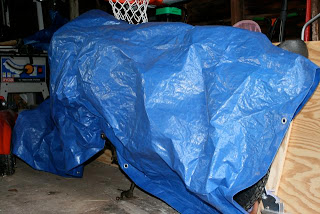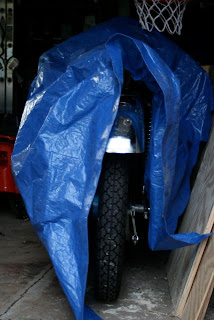Last night we completed another key interview for the film and now we're down to only one left on the list. That isn't to say we won't be doing more, or doing additional interviews of subjects we've already spoken with but what it does mean is that we're one interview away from putting together what we're calling the "outline cut".
This is where we take everything we've shot so far, put it together in the timeline and watch it end-to-end. The goal here is to see what we have, identify the stories we want to focus on and determine what else we need to tell these stories in a compelling way.
So it's not so much the end of production in the traditional sense, but it is the beginning of post-production and a milestone that we've really been looking forward to. Unlike a drama, where the story is written before the camera rolls, this is where the story our film will tell really starts to emerge.
The other transition happening here is a shift in focus from working on the motorcycle to one of working on the film. I have a few bike-related tasks in store for the winter but the updates here will have more to do with "shots-and-cuts" and less to do with "pipes-and-jets" (although bigger jets are on the top of my parts list). The primary challenge facing the bike at the moment is getting the title and license squared away and from my experience that doesn't make for very exciting writing. So unless something particularly exciting happens, I'll spare you the gory details.
We will also be annoucing new posts using our Slimey Mailing List. If you'd like to receive these updates, follow me to sign up.
Look forward to more consistent (if not more frequent) updates and let us know if you like what you're hearing or if there is something you think we're leaving out.
Thursday, October 30, 2008
Monday, October 6, 2008
208 Days

The 2008 fall SCMG Café Racer Run has come and gone and my CL350 project bike (nicknamed by Matt as " CooLeo") gently weeps with only a handful of miles on it since it first arrived here, more than a year ago.
Grounded by lack of clearance from the man (and a few potential mechanical issues), the bike will have to wait through the projected 150" of snow and the dawn of spring to get its first taste of the 'Crud; with the flavor of salt and sand that accompanies the spring roads.

As much as I think the bike had a good shot at making it to the run, when I'm honest with myself about it I admit there is a strong possibility it would not have made it to the end. The potential of mechanical (or more likely, electrical) failure was high given the weather conditions (cold, rain, some hail) and even barring that, I may have simply chickened out once the weather turned.
As it turned out, we took the V45's instead and found that the turnout was fair, but nothing compared to the spring run (weather is a factor, apparently). So even without the project bikes on the road we were able to focus on enjoying the ride, weather and all, and by the time I made it back home I'd logged 300 miles.
…not a bad way to round out the riding season…
I asked Jamie and Libby to help out with the shooting that day, with Lib on "Making Of" duty. Here's a little clip for those of you who didn't make it out on Sunday:
…and while I'd like to gripe about not getting the CL out for this run, there is a reason that these things happen twice a year, right?
Friday, October 3, 2008
Two Days
It's interesting, the motorcycle thing.
In cars, most of the technology is driven by the needs of common, boring street use. Motorcycle technology, on the other hand, seems to be driven primarily by racing, secondarily by nostalgia or physical beauty.
There was a point back in the 1970's or even late '60's where motorcycle technology matched automotive technology in every measurable way. From that point on, bikes took the lead and now there's no comparison.
So with the practical transportation aspirations of automobiles behind them, bikes went down this bizarre road where the only reason to get excited about a new bike is either numerical gains on the dyno or aesthetic (specifically, visual) beauty. Marketing has honed this to an extent that to the general public, motorcycling is these two things and all of the subtle nuances which make riding great are lost (or at best, ignored).
To summarize, every motorcycle made today from the cheapest beginner bike to the most expensive luxury liner is capable of performance exceeding anyone's "needs", so if you're going to continue to sell new motorcycles you have to focus on things that change over time even though they are irrelevant to what motorcyclists know it's all about.
The sad thing is that we (the people who buy motorcycles) are responsible for this. The evidence is that, throughout the history of the motorcycle (in particular, the last two decades) when manufacturers dared to come out with a model that circumvents this one-upmanship approach to sales, these models go unsold. Often these models become appreciated only long after the manufacturer has dropped them from production due to poor sales (the Hawk GT being an excellent example, but there are many more).
I see electric bikes as a potential cure for this problem. This has nothing to do with efficiency or performance but with the fact that they are different enough from people's expectations that we have a chance to reset the image of what makes bikes sell (out of necessity really, because in the near term electric bikes can't compete with gasoline models on all measureable performance fronts simultaneously). Honda did something like this back in the 1950's when they first brought their bikes to the states ("You meet the nicest people on a Honda"), the bikes were so different as to be perceived as a different class of vehicle from the large hooligan-machines driven only by the violent and the unwashed.
It would be an interesting intellectual experiment, to design a motorcycle company to produce a product like this and tweak the variables until it becomes sustainable (i.e., profitable). Similar things have been done before, Saturn did something like this in automobiles (until their short-sighted parent company pulled the plug on the philosophy and "burned the brand").
...now I have something nice to think about this morning...
As you may have noticed, I don't have any good news to share about the project. With no title in hand the odds are not in favor of getting the bike to the fall run. That's all I'm going to say for now as the whole situation is distressing and I'd rather change the topic.
In cars, most of the technology is driven by the needs of common, boring street use. Motorcycle technology, on the other hand, seems to be driven primarily by racing, secondarily by nostalgia or physical beauty.
There was a point back in the 1970's or even late '60's where motorcycle technology matched automotive technology in every measurable way. From that point on, bikes took the lead and now there's no comparison.
So with the practical transportation aspirations of automobiles behind them, bikes went down this bizarre road where the only reason to get excited about a new bike is either numerical gains on the dyno or aesthetic (specifically, visual) beauty. Marketing has honed this to an extent that to the general public, motorcycling is these two things and all of the subtle nuances which make riding great are lost (or at best, ignored).
To summarize, every motorcycle made today from the cheapest beginner bike to the most expensive luxury liner is capable of performance exceeding anyone's "needs", so if you're going to continue to sell new motorcycles you have to focus on things that change over time even though they are irrelevant to what motorcyclists know it's all about.
The sad thing is that we (the people who buy motorcycles) are responsible for this. The evidence is that, throughout the history of the motorcycle (in particular, the last two decades) when manufacturers dared to come out with a model that circumvents this one-upmanship approach to sales, these models go unsold. Often these models become appreciated only long after the manufacturer has dropped them from production due to poor sales (the Hawk GT being an excellent example, but there are many more).
I see electric bikes as a potential cure for this problem. This has nothing to do with efficiency or performance but with the fact that they are different enough from people's expectations that we have a chance to reset the image of what makes bikes sell (out of necessity really, because in the near term electric bikes can't compete with gasoline models on all measureable performance fronts simultaneously). Honda did something like this back in the 1950's when they first brought their bikes to the states ("You meet the nicest people on a Honda"), the bikes were so different as to be perceived as a different class of vehicle from the large hooligan-machines driven only by the violent and the unwashed.
It would be an interesting intellectual experiment, to design a motorcycle company to produce a product like this and tweak the variables until it becomes sustainable (i.e., profitable). Similar things have been done before, Saturn did something like this in automobiles (until their short-sighted parent company pulled the plug on the philosophy and "burned the brand").
...now I have something nice to think about this morning...
As you may have noticed, I don't have any good news to share about the project. With no title in hand the odds are not in favor of getting the bike to the fall run. That's all I'm going to say for now as the whole situation is distressing and I'd rather change the topic.
Subscribe to:
Comments (Atom)